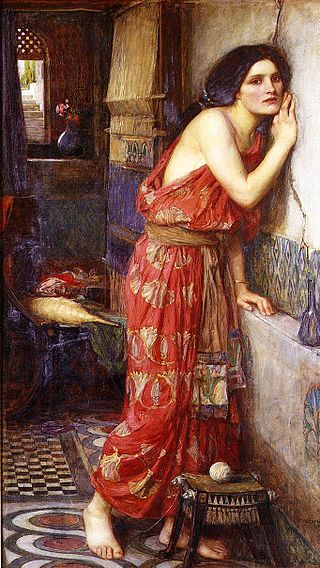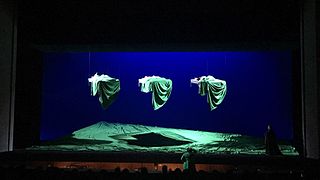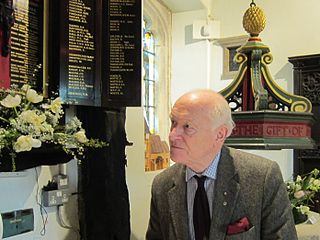Related Research Articles

A Midsummer Night's Dream is a comedy play written by William Shakespeare in about 1595 or 1596. The play is set in Athens, and consists of several subplots that revolve around the marriage of Theseus and Hippolyta. One subplot involves a conflict among four Athenian lovers. Another follows a group of six amateur actors rehearsing the play which they are to perform before the wedding. Both groups find themselves in a forest inhabited by fairies who manipulate the humans and are engaged in their own domestic intrigue. A Midsummer Night's Dream is one of Shakespeare's most popular and widely performed plays.

Pyramus and Thisbe are a pair of legendary, ill-fated lovers from Babylon whose story forms part of Ovid's Metamorphoses. The story has been retold by many authors.
A Teachta Dála, abbreviated as TD, is a member of Dáil Éireann, the lower house of the Oireachtas. It is the equivalent of terms such as Member of Parliament (MP) or Member of Congress used in other countries. The official translation of the term is "Deputy to the Dáil", although a more literal translation is "Assembly Delegate".

The mechanicals are six characters in A Midsummer Night's Dream who perform the play-within-a-play Pyramus and Thisbe. They are a group of amateur and mostly incompetent actors from around Athens, looking to make names for themselves by having their production chosen among several acts as the courtly entertainment for the royal wedding party of Theseus and Hippolyta. The servant-spirit Puck describes them as "rude mechanicals" in Act III, Scene 2 of the play, in reference to their occupations as skilled manual laborers.
A censure is an expression of strong disapproval or harsh criticism. In parliamentary procedure, it is a debatable main motion that could be adopted by a majority vote. Among the forms that it can take are a stern rebuke by a legislature, a spiritual penalty imposed by a church, or a negative judgment pronounced on a theological proposition. It is usually non-binding, unlike a motion of no confidence.

A Midsummer Night's Dream, Op. 64, is an opera with music by Benjamin Britten and set to a libretto adapted by the composer and Peter Pears from William Shakespeare's play, A Midsummer Night's Dream. It was premiered on 11 June 1960 at the Aldeburgh Festival, conducted by the composer and with set and costume designs by Carl Toms. Stylistically, the work is typical of Britten, with a highly individual sound-world – not strikingly dissonant or atonal, but replete with subtly atmospheric harmonies and tone painting. The role of Oberon was composed for the countertenor Alfred Deller. Atypically for Britten, the opera did not include a leading role for his partner Pears, who instead was given the comic drag role of Flute/Thisbe.
Peter Quince is a character in William Shakespeare's A Midsummer Night's Dream. He is one of the six mechanicals of Athens who perform the play which Quince himself authored, "The Most Lamentable Comedy and Most Cruel Death of Pyramus and Thisbe" for the Duke Theseus and his wife Hippolyta at their wedding. Titania's Fairies also watch from a distance: Moth, Peaseblossom, Cobweb and Mustardseed. His name is derived from "quines" or "quoins", which are interlocked oversized corner blocks used by masons to add extra strength at corners and edges of stone walls.
The Legend of Good Women is a poem in the form of a dream vision by Geoffrey Chaucer during the fourteenth century.

Tom Snout is a character in William Shakespeare's A Midsummer Night's Dream. He is a tinker, and one of the "mechanicals" of Athens, amateur players in Pyramus and Thisbe, a play within the play.

Francis Flute is a character in William Shakespeare's A Midsummer Night's Dream. His occupation is a bellows-mender. He is forced to play the female role of Thisbe in "Pyramus and Thisbe", a play-within-the-play which is performed for Theseus' marriage celebration.

Robin Starveling is a character in William Shakespeare's A Midsummer Night's Dream (1596), one of the Rude Mechanicals of Athens who plays the part of Moonshine in their performance of Pyramus and Thisbe. His part is often considered one of the more humorous in the play, as he uses a lantern in a failed attempt to portray Moonshine and is wittily derided by his audience.
Metatheatre, and the closely related term metadrama, describes the aspects of a play that draw attention to its nature as drama or theatre, or to the circumstances of its performance. "Breaking the Fourth Wall" is an example of a metatheatrical device.
Pyramus and Thisbe is a "mock opera" by the German-born composer John Frederick Lampe on the story of Pyramus and Thisbe. It was first performed at Covent Garden Theatre, London, on 25 January 1745. The anonymous libretto is based on Richard Leveridge's The Comickal Masque of Pyramus and Thisbe (1716), itself inspired by the "play within a play" in act 5 of William Shakespeare's A Midsummer Night's Dream.
Thomas Edwards was an English poet who published two Ovidian epic poems Cephalus and Procris and Narcissus. Beyond his name, nothing is known with certainty of Edwards. He has been provisionally identified with a Shropshire law student of that name who transferred from Furnival's Inn to Lincoln's Inn in June 1587, where he shared a room with a known friend of John Donne. Edwards may have contributed the Latin verse to Adriaan van Roomen's Parvum theatrum urbium, published in 1595.

Johann, Johannes or Hans Wechtlin was a German Renaissance artist, active between at least 1502 and 1526, whose woodcuts are his only certainly surviving work. He was the most prolific producer of German chiaroscuro woodcuts, printed in two or more colours, during their period in fashion, though most of his output was of book illustrations.
A Party Wall Surveyor is a person who specialises in resolving disputes arising under the Party Wall etc Act 1996. This legislation is only applicable to England and Wales, which, on 1 July 1997, replaced Part VI of the London Building Acts (Amendment) Act 1939, which was only applicable to the Inner London Boroughs.

The Party Wall etc. Act 1996 introduced a procedure for resolving disputes between owners of neighbouring properties, arising as a result of one owner's intention to carry out works which would affect the party wall, involve the construction of a party wall or boundary wall at or adjacent the line of junction between the two properties or excavation within certain distances of a neighbour's structure and to a lower depth than its foundations.

Alan Henry Puckridge Gillett, OBE is a chartered surveyor who became Master of the Worshipful Company of Chartered Surveyors. Upon retiring from that occupation in 1995, he became Chairman of the Ealing Hospital NHS Trust and was a visiting professor at Kingston University. He has been active in a variety of other associations and, in 2008, was awarded the Order of the British Empire for his services to the Royal Institution of Chartered Surveyors and the community of Ealing, where he was born and still resides.

Lucky and Squash is a 2012 American children's book written by Jeanne Birdsall and illustrated with watercolor paintings by Jane Dyer published by Harper, an imprint of HarperCollins Publishers. The two eponymous characters are dogs based on Birdsall's and Dyer's actual dogs, Cagney and Scuppers, a Boston Terrier and a Tibetan Terrier respectively.
In Greek mythology, Thisbe was a Boeotian nymph, from whom the town of Thisbe derived its name. She may be the naiad of the spring, well or fountain of that town.
References
- ↑ "Spoiling the party". RIBA Journal. Retrieved 3 February 2012.
- ↑ "Party Wall Bill (H.L.)". Parliamentary Debates (Hansard) . 31 January 1996. Retrieved 3 February 2012.